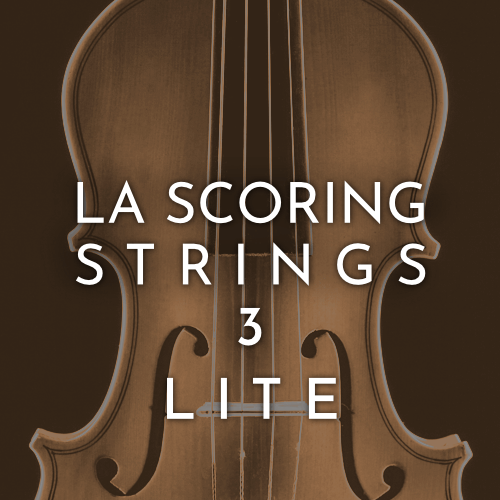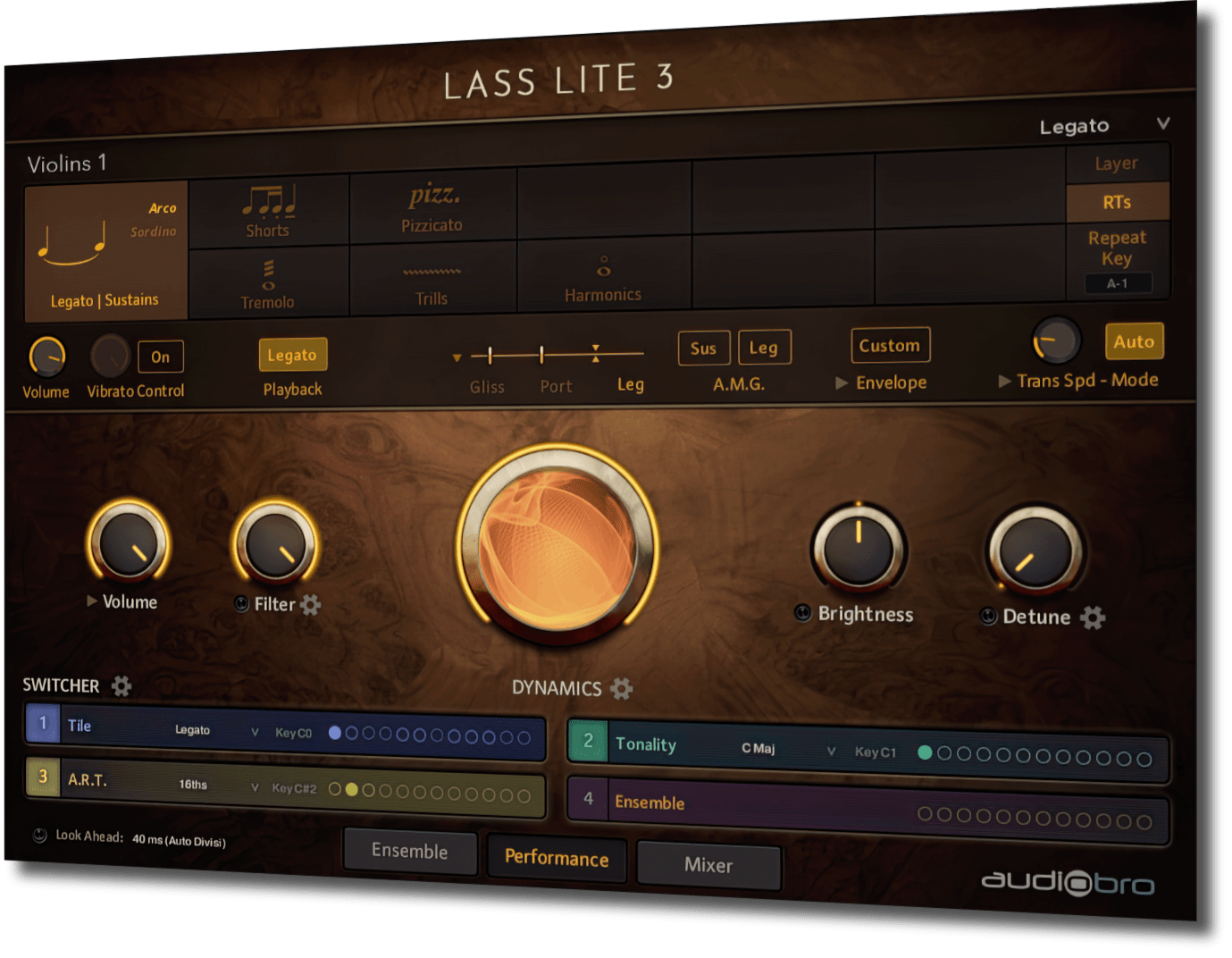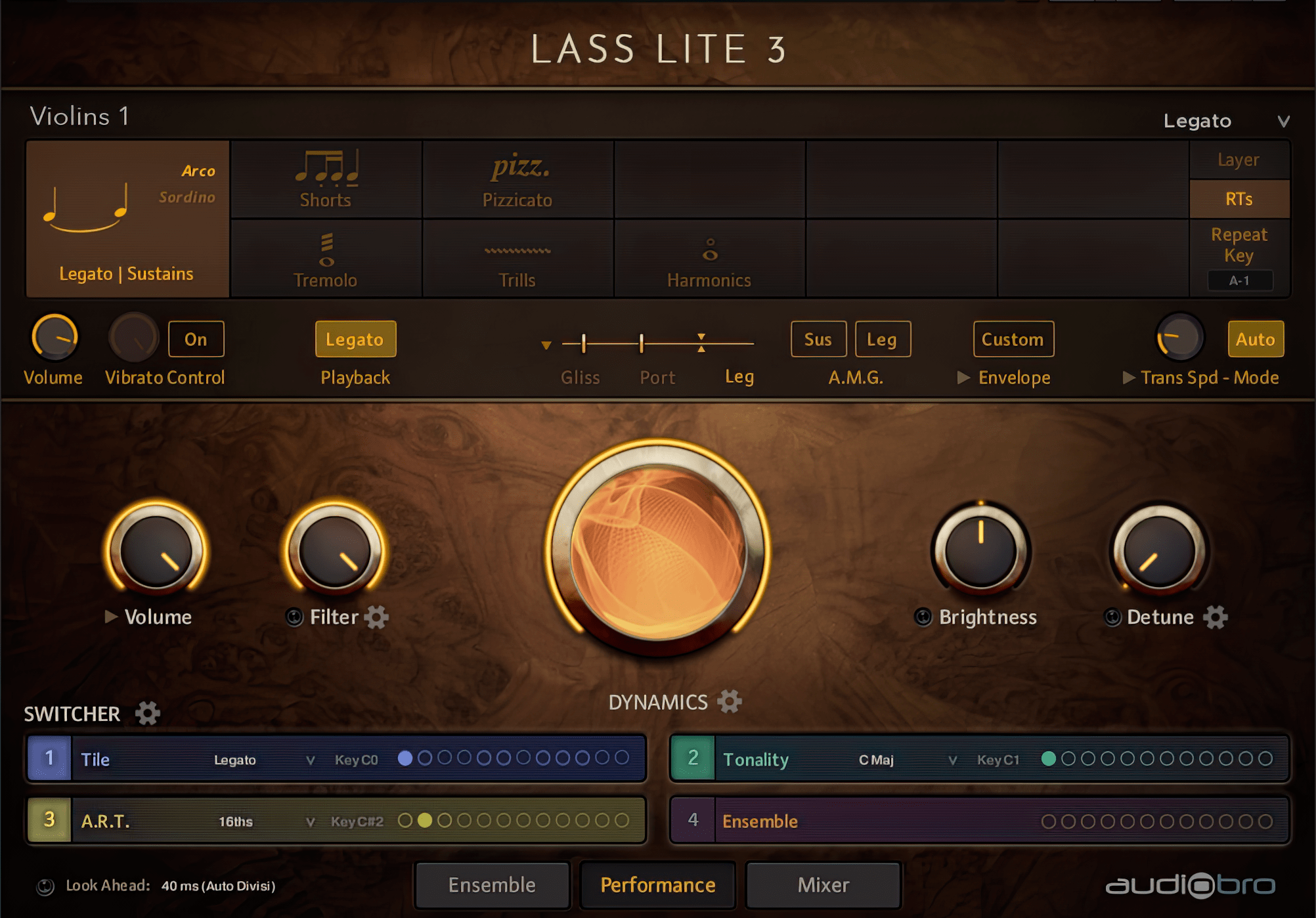LITE
LASS LITE 3 is a library that captures some of the broad expressive range of its full-fledged sibling LASS 3 (complete) without any First Chairs, Legato Sordino, or Divisis (I.e. just the full sections mixed together). What the difference between LASS 3 (complete) and LASS LITE 3?
LASS LITE 3’s instrumentation:
- 16 Violins no divisis
- 16 Violins II no divisis*
- 12 Violas no divisis
- 10 Cellos no divisis
- 8 Basses no divisis
*Violins II samples are borrowed from the Violins I but shifted so as to not cause any phasing when layering.
Here is a partial list of new features to LASS LITE 3:
- Now has “Look Ahead” – saving you from tedious MIDI nudging
- Newly remapped and integrated into our new orchestral engine
- Greater Legato range and flexibility (more exposed transitions for cleaner Legatos)
- Independent real-time control of Legato, Portamento, and Glissando speeds
- Same note rebow – integrated into new patches
LASS is a quantum leap forward
John Debney, ComposerJohn Debney
“I have a myriad of tools at my disposal. None is more crucial to the creative process than the sonic quality of my mock-ups. Presenting to a director a fully orchestrated and realized demo is of paramount importance. LASS is a quantum leap forward in giving me the creative tools to produce realistic mock-ups of my cues. I love the new library and am already using it on two films. I recommend the library highly!”
LASS is essential to my creative process
Lucas Cantor, ComposerLucas Cantor
“From sketching concert pieces to producing epic trailers, LASS is essential to my creative process. The way the library sounds and plays makes writing intuitive and makes demos sound amazing. I have other string libraries but I always reach for LASS first. All my projects with strings start (and usually finish) with LASS.”
I find myself turning to the LASS library
Danny Elfman, ComposerDanny Elfman
“The LASS string library has been my newest addition to my orchestral sample library and has been a great help. Working now on the score to ‘Alice in Wonderland’, I find myself turning to the LASS library for many interesting and useful performance articulations and dynamics that I don’t have with any other library. It’s proving to be very versatile and intuitive. I’m having a great time using the portamento which has always been a problem in the past, and is a large part of this score.”
LASS 3 LITE Details
What’s the Difference Between LASS 3 and LASS 3 LITE?
Take a look at the chart below. LASS 3 LITE contains ONLY the entries in red, while LASS 3 (complete) contains all entries in red and black:

Sections
LASS 3 LITE includes all the major string sections, but not the smaller divisi sections that LASS 3 (complete) does. Below is an image showing you the approximate section layout on the recording stage.
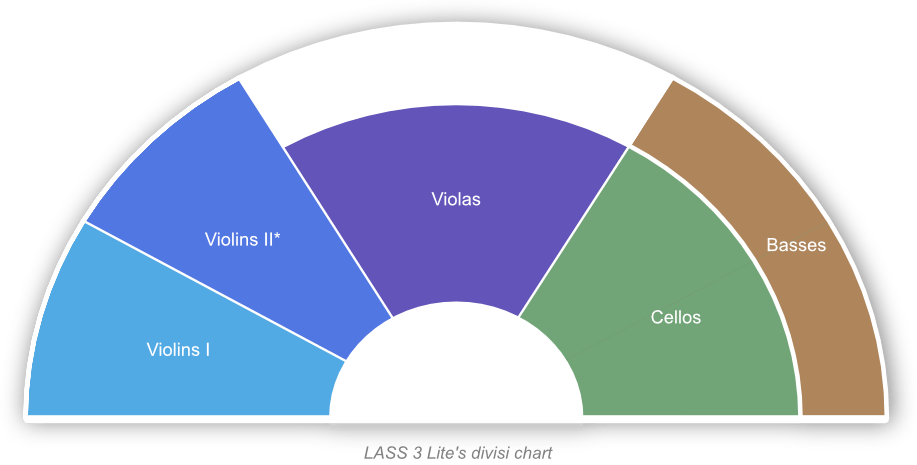
| Violin 1 FC: 1 player | Viola FC: 1 player | Cello FC: 1 player | Bass FC: 1 player |
| Violins Full Mix: 16 players | Violas Full MIx: 16 players | Cellos Full MIx: 10 players | Basses Full Mix: 8 players |
* Violins 2 players are derived from the same sample pool as Violins 1, except we programmed them to not phase when played with Violins 1
Access To All Articulations In One Patch
 The main performance page interface allows quick access to all the main playback controls. Instruments come pre-configured for easy articulations switching but setting things up your own way is simple and intuitive. We have carefully programmed and combined multiple divisis into single patches making it simple and intuitive to load a group of divisis or a single divisi — you have total control. With our newer intelligent Auto Divisi, you can simply play and our engine will distribute the divisi sections evenly to your chord tones avoiding the dreaded (and fake-sounding) samples build-up sound so familiar in other libraries.
The main performance page interface allows quick access to all the main playback controls. Instruments come pre-configured for easy articulations switching but setting things up your own way is simple and intuitive. We have carefully programmed and combined multiple divisis into single patches making it simple and intuitive to load a group of divisis or a single divisi — you have total control. With our newer intelligent Auto Divisi, you can simply play and our engine will distribute the divisi sections evenly to your chord tones avoiding the dreaded (and fake-sounding) samples build-up sound so familiar in other libraries.







Auto Rhythm Tool
The video above is a generic ART video demonstrating the ART engine. The actual samples were made using MSS.
The Auto Rhythm Tool affectionately referred to as ART, has had a major upgrade. ART creates compelling syncopated rhythms that make it easy to sound virtuosic. Simply hold down some notes and let ART do all the hard work for you. Also, ART can now switch between Staccato and Spiccato automatically and has an Arpeggio mode and other new advanced syncing features. Watch the video above to learn more.
The improved ART features:
- MIDI drag-drop to your sequencer. The #1 most requested feature for A.R.T. Capture your performance and drag the MIDI right in to your DAW.
- Notated Rhythm patterns. No longer is each step of A.R.T. relegated to a single note value. Now you can easily notate note and rest durations. Better yet – A.R.T. can switch between the pre-recorded selection of short lengths based on your notation and the host tempo. It also works with all 4 A.R.T. modes. Speaking of which…
- While A.R.T. classic works just like you remember in LASS, A.R.T. New automatically keeps your playing in time without needing any keyboard precision.
- New ARP mode lets A.R.T. work as an arepggiator as well, with 15 pre-defined patterns.
- New Ostinato Tool – a hybrid of an arpeggiator and a step sequencer. Lets you program your own arpeggiated patterns with separate settings for each chord-size (up to 6 note chords).
- Sometimes it’s the little things: Swing, Humanization, Velocity Syncing, Latching.
Look Ahead
This is rather groundbreaking… are you spending far too much time tediously trying to get all your MIDI to sound in time? The exclusive Look Ahead feature in Audiobro’s orchestral engine adds a new way to improve the MIDI timing of all your articulations. Just set your MIDI track to a negative delay (as shown on the library UI) and turn on Look Ahead. Check out the video below to learn more:
Deep DAW Integrations
Meticulous micro-editing (without all the editing)
Using the included robust Articulation Sets and Expression Maps, users of Logic X and Cubase can tightly integrate Modern Scoring Strings articulations and settings directly into their DAWs. This allows for easier changing of articulations during and after recording in your parts without the ugly extra notes appearing in your piano roll and score editors. But taken to their full potential, these integrations also allow you to control the most critical performance features to get a great and expressive performance without the need for memorizing random CCs and KeySwitch notes.
A few advantages of using Articulation Sets or Expression Maps:
- Set up live articulation switching directly in Logic/Cubase using a variety of methods
- Keep keyswitch notes and/or CCs out of your MIDI regions for easier reading and exporting of piano rolls and scores
- Easily gain access to critical Modern Scoring Strings settings without any deep editinga of random CCs required
- Completely customizeable to your liking
- Unify your preferred articulation switching methods across libraries
Learn more by watching Logic and Cubase integration videos below:
Ensemble and Stage
The Ensemble page is where the Stage and Audiobro’s coveted Auto Divisi and Delay & Humanization (DNH) features typically reside. On the light version (LASS 3 Lite) you will only have the “Full Mix” (combined divisis mixed down) on the stage for panning. But this affords you to place a full section anywhere on the “stage” you want.
Some of the Ensemble Pages’s main features include:
- 52 ambiance presets using exclusive Audiobro IRs
- Air absorbtion based in stage positioning
- X/Y pad for easy placement of players
- Independent volume, width and pan
- Adjustable Stage amounts for each microphone
Because LASS 3 Lite doesn’t have any divisis, the Stage section will not be as feature-rich as the LASS 3 (complete) version, but you still get many of the benefits.
The Mixer with Sonic Profiles
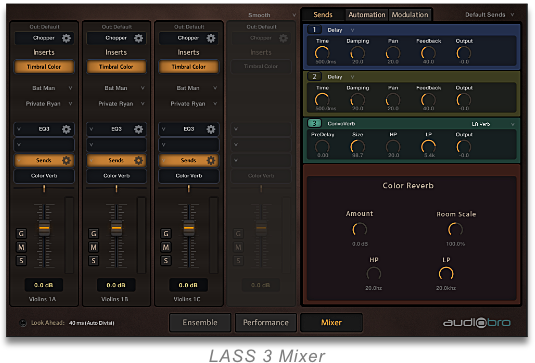
LASS 3 Lite’s new Mixer engine features one of our popular LASS Sonic Profiles (Bat Man) that allows you to mimic the sound of famous scores with the click of a button. The LASS 3 (complete) library has over 16 to choose from. In addition, the mixer still has our extensive Modulation, Automation and Effects Sends sections that allow you to tailor your sound in compelling ways while keeping things simple and intuitive.
Our new mixer has advanced features like:
- Bat Man Sonic Profile – a proprietary IR that mimics the sound of a famous scores
- Sordino Bat Man Sonic Profile – IR to be used with the sordino samples that mimics the sound of famous score
- 20 user definable Mixer snapshots
- 28 Effects plugins
- Over 50 filters to choose from
- Put any effects or filters in any order in our insert slots
- Assign MIDI CCs to a plugin effect parameter
- Modulation Tables to create compelling sonic landscapes
- Chopper – rhythmically stutter any channel to your specifications
Komplete Kontrol and NKS

LASS 3 integrates seamlessly with Native Instrument’s Komplete Kontrol software and NKS* eco system.
Control the most important features of LASS 3 directly from NI hardware and using your sequencer’s device automation. We’ve made it quicker and easier to find sounds – browse and load all KOMPLETE Instrument presets from a single plugin. Knobs will display all the relevant controls on NI’s LED displays.
Learn more about NKS here:
System Specifications for LASS 3 LITE
LA Scoring Strings 3 Lite Library Size:
- About 4GB with lossless compressed audio files (approximately 6GB uncompressed). 8GB required during installation for the entire 4GB library.
NOTE: Once successfully installed, please make a safe backup of the library for future reference. There is a $5 Amazon Web Server costs re-download fee if you want to re-download all of LASS 3′s sample data.
Supported Interfaces:
- Stand-alone, VST®, Audio Units™, AAX®
Minimum System Requirements:
- Requires Kontakt Player 6.1.1 or later. Click here to download the latest free version of Kontakt Player.
- Windows — Windows 7, Windows 8, Windows 10 (latest service pack), Intel Core Duo or AMD Athlon 64 X2, 4 GB RAM (over 6 GB recommended – the more RAM, the better!) *** Windows XP is no longer supported. ***
- Mac — Mac OS 10.13, 10.14, 10.15 or 11 (latest update), i5, 4 GB RAM (over 8 GB recommended – the more RAM, the better!)
* NKS is a registered trademark of Native Instruments GmbH.


Potential Upgrade Paths
There is an upgrade path for previous LASS owners. Existing customers, the easiest way to view your savings is to log into our store with your Audiobro credentials here: Login.
Your prices will automatically be adjusted for you.
